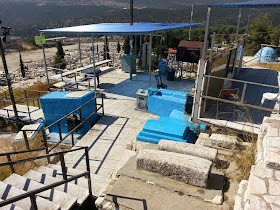On January 22, Israel is going to vote a new parliament into the Knesset. I have to admit that, while reading the paper, I ignore most articles dealing with Knesset parties and their intrigues and affairs. Just like me, many Israelis are sick of politics and the corruption in our country. Nevertheless, politics are also a subject in the rather sleepy town of Zfat.:-)
Here, everything seems to be so far away but, in contrast to many American Jews living in Zfat, the secular Israeli population has its feet much more on the ground. Despite all dirty politics, here are another few rather romantic pictures from Tiberias and Zfat:
Tiberias
Photos from Zfat
Yesterday: 28 degrees Celsius in Zfat. Some local shopkeepers asked an American tourist group where they are from in the States: "From Pennsylvania", was the response. "So you are probably happy to be here", said the shopkeepers referring to hurricane Sandy. "Oh, yes, !" - so the Americans.
Copyright / Photos: Miriam Woelke






































.jpg)




